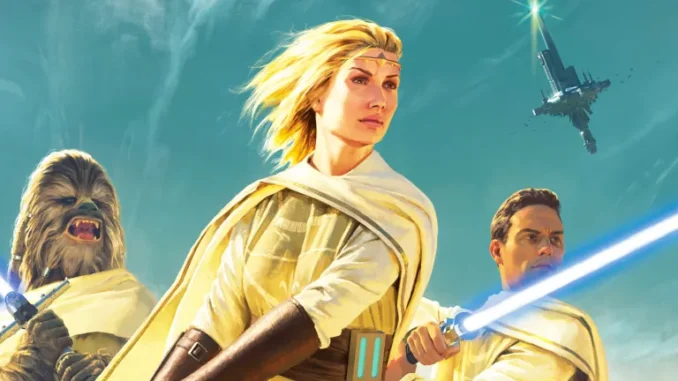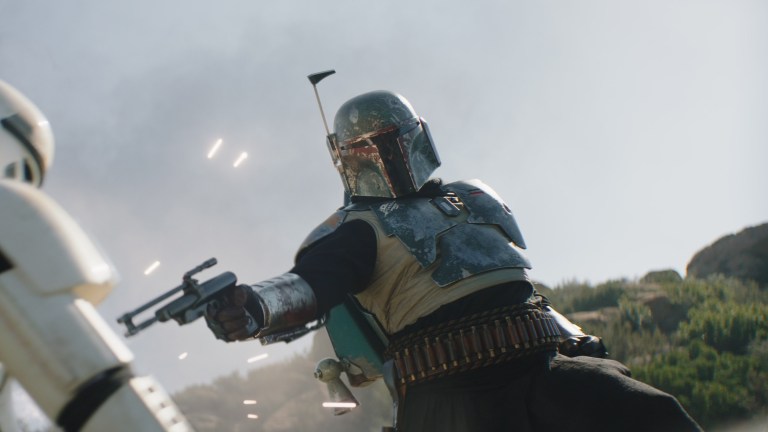
Star Wars The High Republic: Light of the Jedi Review
In the new Star Wars novel The High Republic: Light of the Jedi by Charles Soule, a starship has broken up in hyperspace, an accident that wasn’t supposed to be able to happen. The Jedi of the High Republic era (set 200 years before The Phantom Menace), noble, strong, and united by the battle meditation of Avar Kriss, go to the scene of the accident to rescue survivors and prevent the debris from destroying a planetary system. As the Jedi start to unravel the mystery of how the accident happened, their enemies are gaining more information, too. The Nihil, once a loosely connected band of pirates, is forming into a killing scalpel as its leader makes some discoveries of his own. The two groups are on a collision course.

With The High Republic series, which also consists of the young adult novel Into the Dark, middle-grade book A Test of Courage, and comics from Marvel and IDW, the team of authors reverse engineers the MCU model, introducing dozens of new characters at once, and then digging into their personalities and backstories later. It means Light of the Jedi is refreshingly free of info-dumps: the scenes themselves illustrate new ideas. For example, this era has cool starfighters the Jedi pilot with the Force alone. A Jedi of this era only draws their lightsaber if they’re willing to use it, and each character feels and connects with the Force in distinct ways. If these Jedi are superheroes, they can be distinguished by these traits. This one experiences the Force as music, this one as an ocean.
It’s the ultimate Star Wars in medias res, offering an excellent adventure if you’re able to just stick around long enough to figure things out. The first Del Rey novel in the series has plenty of reasons for me to want to stick around. Cool creatures, inventive action that bends but never breaks the rules of the Force, and compelling relationships and perspectives are all here. But Light of the Jedi also requires the reader to do some work, with an opening that introduces so many characters there’s no time to understand why one should care about any of them. Someone in this book is named Wet Bub.
The plot is broken up into two large sections that bounce around between events and perspectives. What’s at stake? The reputation of the Republic, now expanding into the outer reaches of the galaxy. Who has to make a choice? All of the Jedi, all in their own ways, but none who take the full weight of the plot. It starts the series off with a bang, certainly, introducing the vast number of Jedi and their allies, but the best human touches come only at the end. Sometimes I wondered whether the whole book could be reversed, starting off with smaller moments and building to a big climax that instead gets the book going. The opening is too clean and shiny (perhaps an intentional divergence from the usual Star Wars grunge look). The dialogue is choppy, the characterization vague.
You have to be willing to settle in, and perhaps read the other books in the series so the characters begin to feel a bit more like a central cast, and then you can pick a favorite and read for them. In Marvel terms, pick your hero. Does all of that sound like work? Maybe it does. I don’t generally like the “just wait until it gets good” method of consuming media, and that was very much my experience here. Scenes put in place for context simply feel meandering.
I kept coming back to the fact that I counted 11 named characters in the first third, and that none of them are listed on the front flap. And the lack of a true main character makes it difficult to describe what happens without turning the book upside down and inside out.
But once Light of the Jedi got going, I had a lot of fun. This really is a book about good people, including politicians and ship captains who are easy to root for. The novel isn’t deep, doesn’t interrogate decades of Jedi discourse and re-knit them from the inside — but it does the work to prove that being good can be deep and difficult too, that good people are complicated. These Jedi have lots of different perspectives, opinions, and their own personal moral lines they will and won’t cross. Best of all, the book shows that good is cool, especially as illustrated by a daring rescue on alien horseback.
And I chose which heroes I wanted to see on my backpack. Both are on the front cover — Avar Kriss and Elzar Mann, old friends who might have been lovers if they hadn’t been Jedi. Avar is the quintessential Jedi Master — serene, kind, focused, effortlessly comfortable connecting the minds of dozens of people around her. In contrast, Elzar is an unpredictable “tinkerer,” interested in what he sees as the depths of the ocean that is the Force. Jedi apprentice Bell also gets a nice little arc about learning to use an impressive power, but “having a character arc” is a low bar for a novel to reach. Many of the other characters felt like sketches or profiles more than fully fleshed out people.
Overall, Light of the Jedi is a Star Wars adventure full of potential, thanks to what’s on the page as well as how it’s informed by the original 1977 movie. The book also found in me an emotion it sometimes becomes hard to access these days. There’s a lot of justification required to like something lately. The people who unabashedly enjoy things they don’t find technically good are often the quiet ones, disinterested in the very justifications that would make noise online. Even the very fact that I try to write seriously about tie-in novels, a subgenre that gets blanket scorn from one side of the spectrum and blanket approval from the other, sometimes forces me to veer away from apparent contradictions. I need to get back to thinking a different way. This book isn’t technically good. And I liked it.
